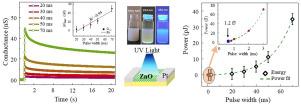通过表征超低功耗(∼ fJ)氧化锌基光电突触中的兴奋性突触传递,实现持久光电导性和仿效艾宾浩斯遗忘曲线
IF 6.9
2区 材料科学
Q2 CHEMISTRY, PHYSICAL
引用次数: 0
摘要
光突触可为神经形态计算提供低功耗的高带宽操作。氧化锌在紫外线(UV)区域具有很高的光敏性,因此被认为是一种潜在的光电突触半导体。在这项工作中,我们的重点是在基于氧化锌纳米粒子的横向突触器件中,通过电导衰减和记忆保持来模拟艾宾浩斯遗忘曲线。我们使用波长为 375 纳米的紫外线进行光刺激。记忆保持时间长达 2500 秒,显示出对记忆和学习能力有用的长期潜能。利用光刺激实现了长时间记忆保持,并对记忆的衰减特性进行了研究。通过调整光脉冲宽度,可以诱导从短期可塑性(STP)到长期可塑性(LTP)的过渡。研究发现,能量消耗随应用的光脉冲宽度呈指数增长。电导衰减遵循艾宾浩斯遗忘曲线。我们证明了脉冲宽度、脉冲频率和脉冲幅度等各种测量参数对记忆衰减的影响。该突触器件的能耗可低至 1.2 fJ,为神经形态应用中的低能耗突触器件铺平了道路。本文章由计算机程序翻译,如有差异,请以英文原文为准。

Persistent photoconductivity and Emulating Ebbinghaus forgetting curve via characterization of excitatory synaptic transmission in a ZnO-based optoelectronic synapse with ultra-low power (∼ fJ) consumption
Optical synapses provide high bandwidth operation with low power consumption for neuromorphic computing. ZnO is established as a potential semiconductor for optoelectronic synapses with its high photosensitivity in the ultraviolet (UV) region. In this work, we focus on emulating Ebbinghaus forgetting curves via conductance decay and memory retention in a lateral synaptic device based on ZnO nanoparticles. We use optical stimulation using UV light of wavelength 375 nm. Retention of memory can be seen up to 2500 sec showing long-term potentiation which is useful for memory and learning abilities. Long-duration memory retention using optical spiking is achieved and the decay characteristics of the memory are studied. A transition from short-term plasticity (STP) to long-term plasticity (LTP) can be induced by tuning the optical pulse width. Energy consumption is found to increase exponentially with the applied optical pulse width. The conductance decay follows the Ebbinghaus forgetting curve. We have demonstrated the effect of various measurement parameters such as pulse width, pulse frequency, and pulse amplitude on memory decay. The synaptic device can be operated with energy consumption as low as 1.2 fJ which paves the way for very low energy-consuming synaptic devices for neuromorphic applications.
求助全文
通过发布文献求助,成功后即可免费获取论文全文。
去求助
来源期刊

Applied Surface Science
工程技术-材料科学:膜
CiteScore
12.50
自引率
7.50%
发文量
3393
审稿时长
67 days
期刊介绍:
Applied Surface Science covers topics contributing to a better understanding of surfaces, interfaces, nanostructures and their applications. The journal is concerned with scientific research on the atomic and molecular level of material properties determined with specific surface analytical techniques and/or computational methods, as well as the processing of such structures.
 求助内容:
求助内容: 应助结果提醒方式:
应助结果提醒方式:


